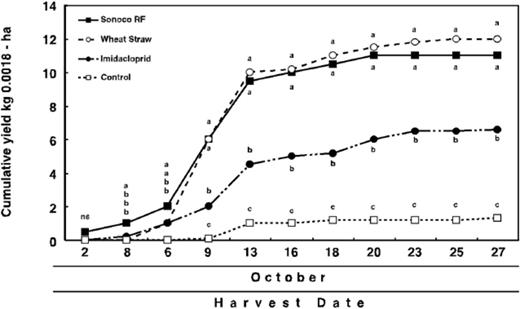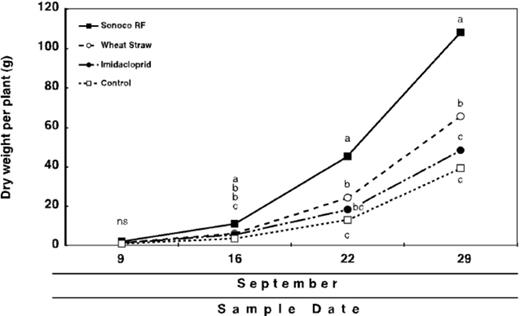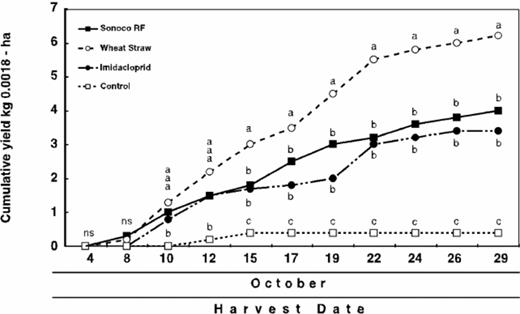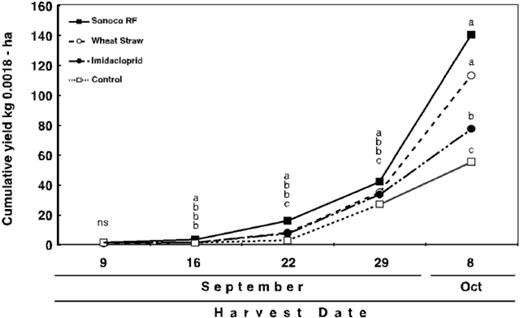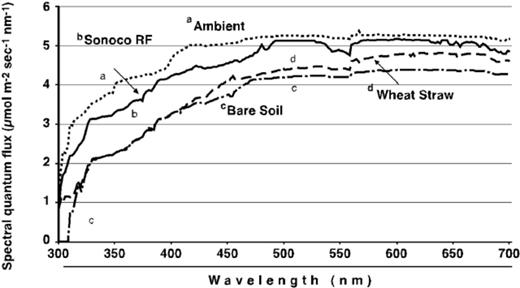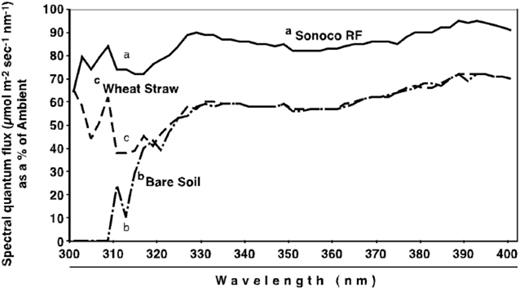-
PDF
- Split View
-
Views
-
Cite
Cite
Charles G. Summers, Jeffrey P. Mitchell, James J. Stapleton, Management of Aphid-Borne Viruses and Bemisia argentifolii (Homoptera: Aleyrodidae) in Zucchini Squash by Using Uv Reflective Plastic and Wheat Straw Mulches, Environmental Entomology, Volume 33, Issue 5, 1 October 2004, Pages 1447–1457, https://doi.org/10.1603/0046-225X-33.5.1447
Close - Share Icon Share
Abstract
Plastic UV reflective mulch (metalized mulch) and wheat straw mulch delayed colonization by Bemisia argentifolii Bellows & Perring and the incidence of aphid-borne viruses in zucchini squash. No insecticides were used in either mulch treatment. The mulches were compared with a preplant treatment of imidacloprid and an untreated, unmulched control. In 2000, yield of marketable fruit in the plastic and straw mulched plots was approximately twice that from the imidacloprid plot. In 2001, yield from the straw mulch plots was twice that of the imidacloprid and plastic mulch plots. Yields from both mulched plots and from the imidacloprid plots ranged from 3 to 12 times higher than those from the control plots. The mulches were more effective than a preplant application of imidacloprid in reducing the incidence of both B. argentifolii and aphid-borne viruses. Plants growing over the plastic mulch and the straw mulch grew more rapidly and reached a larger size, as determined by plant dry weight, than did those growing over bare soil, with or without imidacloprid. The spectral quantum flux from the plastic averaged between 80 and 90% of ambient spectral quantum flux values in the UV (300–400-nm) range. Spectral quantum flux values of wheat straw were similar to those of the reflective mulch and ambient near 300 nm but were virtually identical to bare soil beyond 320 nm. The metalized mulch reflected 94% of the incoming photosynthetically active radiation (PAR) in the 400–700-nm range compared with ambient, whereas the straw mulch reflected 85%. Bare soil reflected only 41% of incoming PAR compared with ambient.
Introduction
ZUCCHINI SQUASH, Cucurbita pepo L., is susceptible to several aphid-borne viruses, including cucumber mosaic (CMV) cucumovirus, zucchini yellow mosaic (ZYMV), and watermelon mosaic (WMV) potyviruses. All are transmitted in a nonpersistent manner by several aphid species, with alates being the principal vector. In California, the cotton/melon aphid, Aphis gossypii Glover, is the most important vector (Summers et al. 1995). Plants may become infected with one or more of the viruses during their development. Plants infected by multiple viruses generally suffer more damage than those infected with a single virus. Insecticides offer little relief, because the viruses are acquired and transmitted within 20-30 s, usually before the aphid vector acquires a lethal insecticide dose (Gibson and Rice 1989). Some insecticides may actually enhance virus spread (Ferro et al. 1980). Bemisia argentifolii Bellows & Perring is also a serious pest of zucchini squash. Injury occurs by the direct feeding of both adults and immatures. In addition, the nymphs, but not the adults, cause a physiological condition known as silverleaf that leads to a silvering of the leaves and a blanching of the fruit, which renders it unmarketable (Costa et al. 1993, Schmalstig and McAuslane 2001). Whitefly management using chemicals has not been effective (Denholm et al. 1996, Horowitz and Ishaaya 1996), and there are few examples of effective biological control in vegetables (Heinz 1996, Hoelmer 1996). B. argentifolii rapidly develops resistance to all classes of insecticides (Denholm et al. 1996, Prabhaker et al. 1998, Elbert and Nauen 2000).
UV reflective plastic mulches have been used successfully to delay and reduce the incidence of aphid-borne virus diseases in squash and other crops (Brown et al. 1993; Summers and Stapleton 1998, 1999; Stapleton and Summers 2002) and to delay colonization by B. argentifolii and reduce the incidence of squash silverleaf (Edelstein et al. 1991, Summers and Stapleton 2002). These mulches reflect short-wave UV light (Loebenstein and Raccah 1980, Harpaz 1982), which confuses and repels incoming alate aphids and adult whiteflies, thus reducing their incidence of alighting on plants (Kring 1972).
Wheat straw also may reduce aphid and virus incidence. Liewehr and Cranshaw (1991) determined that straw mulch decreased the incidence of alate aphid landings. Rummel et al. (1995) found that wheat straw mulch retarded aphid development on cotton. Bwye et al. (1999) found a decrease in the incidence of CMV in narrow-leafed lupine plants grown over wheat straw, and Jones (1994) observed reduction in the incidence of bean yellow mosaic potyvirus in lupines planted over cereal straw. Burton and Krenzer (1985) noted that greenbug, Schizaphis graminum (Rondani), populations were substantially reduced in plots where surface residues or wheat straw were moderate to high, compared with conventionally tilled plots. They suggested that wheat surface residues may serve as a reflective mulch that either repels the settling aphids or masks the existing attractancy of conventionally tilled plots.
The objective of this study was to determine whether alate aphids, aphid-borne viruses, and B. argentifolii could be managed without insecticides by growing a squash crop over UV reflective plastic or wheat straw mulch.
Materials and Methods
Plot Preparation, Irrigation System, and Experimental Design
Planting beds were formed with a tractor drawn Culti-mulch bed shaper (B. W. Implement Co., Buttonwillow, CA) with a distance between beds of 76 cm. Plots were three beds in width by 12.3 m in length in 2000 and five beds in width by 7.6 m in length in 2001. Each plot was separated from adjacent plots by 4.6 m of bare soil on all sides. Fertilizer (15-15-15, N-P-K) at 560 kg ha-1 and bensulide (Prefar) herbicide at 5.6 kg ([AI]) ha-1, in 189 liters of water per hectare, were applied and incorporated to a depth of 15 cm with a second pass of the bed shaper. Before applying the mulches, drip tape (t-tape, TSN 506-20-500, Rain for Rent, Fresno CA) was laid down the center of each bed. Beginning 2-3 wk after seedling emergence, additional N (liquid 17-0-0), at 26 kg ha-1 was applied through the drip system weekly.
Treatments were arranged in a randomized complete block design with six replications. Treatments consisted of UV reflective plastic mulch (Sonoco RF, a metalized mulch casting the appearance of aluminum foil), scattered wheat straw ('Bonus'), soilinjected preplant imidacloprid, and a bare soil control. The polyethylene mulch was applied by stretching the plastic over the planting beds and securing the edges with soil. The wheat straw was scattered over appropriate beds at the rate of 11,200 kg ha-1. Squash in the San Joaquin Valley is grown from seed rather than transplants. Preplant insecticides treatments such as imidacloprid are often used to control whiteflies and aphids. To reflect grower practices, imidacloprid at 0.28 kg ([AI]) ha-1) in 189 liters of water per hectare was shanked into the soil by using a three-point hitch tractor mounted shank ≈5 cm below the seed placement 1 d before planting. A CO2-propelled backpack sprayer was used by connecting the insecticide tank to the injection shank and injecting the imidacloprid at a pressure of 138,000 Pa.
Planting holes were cut in the center of each plastic mulch strip. Spacing between plants in all treatments was 45 cm. Three squash seeds ('Ambassador', Seminis Seeds, Oxnard, CA) were planted per hill on 28 and 30 August 2000 and 2001, respectively. After seedling emergence, plants were thinned to one per hill.
Aphid and Whitefly Sampling
Alate aphid and adult whitefly counts were made by selecting one newly expanded leaf from each plant in the center row of each plot, gently turning it over and counting the number of individuals present. Nymphal whitefly populations were determined by selecting an ≈3-wk-old leaf from each plant in the center row, placing it in a self-sealing plastic bag and returning it to the laboratory. In total, 12 plants per plot were sampled. A 3.25-cm2 core was taken from each leaf, and the number of individuals on the core counted. Leaf plugs were then examined under the microscope and the number of nymphs (except crawlers) determined.
Virus and Silverleaf Incidence and Yield Determination
The incidence of plants presenting virus and silverleaf symptoms was determined weekly by visual inspection. Cucumber mosaic virus, ZYMV, and WMV comprise >95% of the virus diseases associated with cucurbits in the San Joaquin Valley (Summers et al. 1995, Grafton-Cardwell et al. 1996, Stapleton and Summers 2002, Summers and Stapleton 2002). No attempt was made to distinguish between the three viruses. At maturity, fruit was picked from the center row of each plot every other day, scored as marketable or unmarketable, weighed, and yields recorded. The unmarketable category included fruit with virus symptoms and those bleached by whitefly feeding.
Biomass Determination
Plant biomass was determined weekly by selecting two plants from a guard row in each plot, beginning 10 d after planting. Care was taken to avoid any plants showing virus symptoms. The plants were cut at soil level, placed in paper bags and returned to the laboratory. Bags were placed in a drying oven at 70°C for 5 d after which they were removed and plant dry weight determined.
Spectral Reflectance Determinations
Spectral energy distributions from the mulches were performed with a LiCor 1800 (LiCor, Inc., Lincoln, NE) radiometer by using a cosine-corrected sensor (Dokoozlian and Kliewer 1995). Scans were performed at 2-nm intervals between the wavelengths of 300 and 700 nm. Ambient (incoming) radiation was measured by positioning the sensor of the remote head vertically upward. For measurements of radiation emanating from the mulches, the sensor was positioned directly over the center of each mulch, ≈15 cm above the mulch surface. Measurements, taken on 10 September 2001, were begun at solar noon and required ≈1 h to complete. Skies were clear throughout the period. Four replications of each mulch, including bare soil and incoming ambient radiation, were evaluated. Additional measurements were not taken because the canopy of the rapidly growing plants covered >50% of the mulch surface within approximately 4 wk, largely negating the effectiveness of the mulch (Maelzer 1986).
Statistical Analysis
Adult and nymphal whitefly numbers, alate aphid numbers, plant biomass, total quantum flux, and yields were evaluated by analysis of variance (ANOVA) and the means separated by Fisher's protected least significant difference (LSD) (Abacus Concepts 1989). The percentage of plants presenting virus and silverleaf symptoms was transformed to arcsine square-root values and evaluated by ANOVA and Fisher's protected LSD. Data were then back transformed for presentation.
Results
2000 Trials
Both the UV reflective plastic (Sonoco RF) and the wheat straw mulches were effective in reducing colonization by B. argentifolii adults for up to 1 mo (Table 1). The number of adult whiteflies per leaf was initially high, particularly in week 2, in the imidacloprid-treated plots but then declined rapidly as the insecticide was taken up and became effective in killing the adults. The number of whitefly nymphs per square centimeter followed a similar trend, with the population density in the Sonoco RF, wheat straw, and imidacloprid-treated plots significantly (P < 0.05) below that of the bare soil control plots (Table 1). Silverleaf symptoms, induced by the feeding of B. argentifolii nymphs, first occurred on 25 September, ≈3 wk after seedling emergence. The incidence of squash silverleaf through 9 October was significantly (P < 0.05) lower in plants growing over the UV reflective mulch, the wheat straw, and in plots receiving a preplant application of imidacloprid (Table 1).
Mean (±SEM) no. B. argentifolii adults per leaf, no. nymphs per square centimeter of leaf surface, and the percentage of plants presenting silverleaf symptoms in 2000
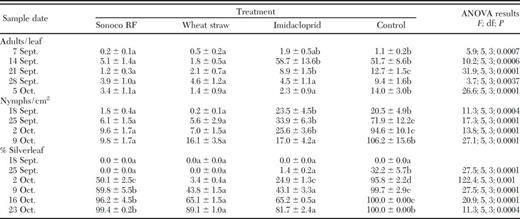
Means within sampling dates followed by the same letter(s) are not significantly different at P < 0.05. Fisher’s protected LSD.
Mean (±SEM) no. B. argentifolii adults per leaf, no. nymphs per square centimeter of leaf surface, and the percentage of plants presenting silverleaf symptoms in 2000

Means within sampling dates followed by the same letter(s) are not significantly different at P < 0.05. Fisher’s protected LSD.
The UV reflective plastic mulch and the straw mulch provided equal protection against aphid-transmitted viruses (Table 2). By 16 October, 6 wk after planting, the incidence of virus infected plants growing over these two mulches was <25%. On the same sample date, the incidence of virus-infected plants in the imidacloprid-treated plots and the bare soil control approached 75%, and they were not significantly different from each other (P > 0.05). The UV reflective plastic and the straw mulch delayed the occurrence of virus infected plants for 3-4 wk beyond that observed in the bare soil and imidacloprid-treated plots.
Mean (±SEM) no. alate aphids per leaf and the percentage of plants presenting virus symptoms in 2000

Means within sampling dates followed by the same letter(s) are not significantly different at P < 0.05. Fisher’s protected LSD.
Mean (±SEM) no. alate aphids per leaf and the percentage of plants presenting virus symptoms in 2000

Means within sampling dates followed by the same letter(s) are not significantly different at P < 0.05. Fisher’s protected LSD.
Plants growing over UV reflective plastic and straw mulch produced significantly (P < 0.05) higher yields than those growing over the imidacloprid and the untreated control plots (Fig. 1). By the third harvest (6 October) fruit production in both mulch treatments accelerated rapidly, out producing both the imidacloprid-treated and the bare soil control plots. The combination of whitefly and virus pressure in the untreated control plots resulted in a nearly complete lack of marketable fruit.
Cumulative yields of marketable squash fruit from plants grown on selected mulches, preplant imidacloprid (bare soil), and a bare soil control in 2000. Yields sharing a common letter (within individual harvest dates) are not significantly different at P < 0.05, Fisher’s protected LSD. NS, nonsignificant.
Mulching had a major impact on plant biomass accumulation (Fig. 2). Plants growing over the UV reflective plastic produced significantly (P < 0.05) more biomass, more quickly, than did plants growing over any other treatment. Those growing over the straw mulch accumulated biomass significantly (P < 0.05) more rapidly that did those growing over bare soil.
Cumulative plant biomass, dry weight (grams) per plant, of squash plants grown on selected mulches, preplant imidacloprid (bare soil), and a bare soil control in 2000. Values sharing a common letter(s) (within individual sample dates) are not significantly different at P < 0.05, Fisher’s protected LSD. NS, nonsignificant.
2001 Trials
Whitefly populations were higher in 2001 than in 2000. The Sonoco RF and the wheat straw mulches protected the plants from colonization by adults significantly (P < 0.05) better than did imidacloprid and wheat straw protection was superior to that afforded by the UV reflective mulch (Table 3). In most cases, adult densities in the imidacloprid plots were equal to those in the bare soil control plots. Likewise, whereas the number of nymphs per square centimeter was much higher in 2001 than 2000, the Sonoco RF and wheat straw mulched provided significantly (P < 0.05) greater protection than did imidacloprid (Table 3). The occurrence of squash silverleaf in 2001 was similar to that observed in 2000, with the first plants in the imidacloprid and control plots showing symptoms on 24 September (Table 3). Although no symptoms were observed the previous week (17 September), 1 wk later (24 September) 44% of the plants in the control plots presented symptoms. By 1 October, 100% of the plants in the bare soil control plots showed symptoms. Imidacloprid lost its effectiveness by 1 October when >50% of the plants in treated plots presented silverleaf symptoms. Although imidacloprid was relatively effective in reducing the incidence of silverleaf in 2000, it was not as effective in 2001. The Sonoco RF mulch provided protection through 1 October, but 1 wk later (8 October) nearly 100% of the plants growing over this mulch presented symptoms. The wheat straw provided the longest period of protection. Substantial silverleaf symptoms were delayed until 15 October. The incidence of silverleaf in these plots did not equal that occurring in the control plots until 22 October, which was only 1 wk before the cessation of harvest.
Mean (±SEM) no. B. argentifolii adults per leaf, no. nymphs per square centimeter of leaf surface, and the percentage of plants presenting silverleaf symptoms in 2001
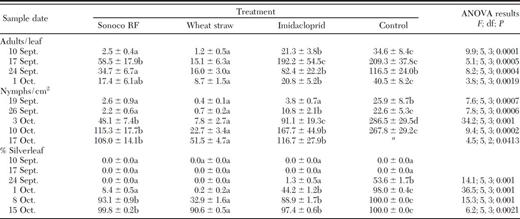
a Plants in the control plot were dead and thus excluded from the ANOVA.
Means within sampling dates followed by the same letter(s) are not significantly different at P < 0.05. Fisher’s protected LSD.
Mean (±SEM) no. B. argentifolii adults per leaf, no. nymphs per square centimeter of leaf surface, and the percentage of plants presenting silverleaf symptoms in 2001

a Plants in the control plot were dead and thus excluded from the ANOVA.
Means within sampling dates followed by the same letter(s) are not significantly different at P < 0.05. Fisher’s protected LSD.
Virus incidence was much lower in 2001 than in 2000 (Table 4). Virus disease symptoms were scarce until mid-October. Both the Sonoco RF mulch and the wheat straw mulch provided excellent protection from virus infection throughout the majority of the growing season. Imidacloprid failed to provide any practical protection; the incidence of virus infection in these plots not differing significantly (P > 0.05) from that in the bare control plots (Table 4).
Mean (±SEM) no. alate aphids per leaf and the percentage of plants presenting virus symptoms in 2001
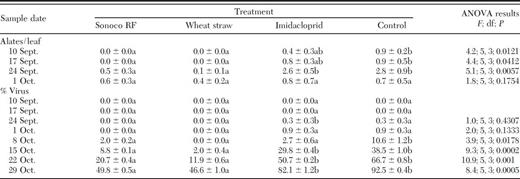
Means within sampling dates followed by the same letter(s) are not significantly different at P < 0.05. Fisher’s protected LSD.
Mean (±SEM) no. alate aphids per leaf and the percentage of plants presenting virus symptoms in 2001

Means within sampling dates followed by the same letter(s) are not significantly different at P < 0.05. Fisher’s protected LSD.
All mulch treatments, and the imidacloprid treatment, produced significantly (P < 0.05) higher yields than did the control plots (Fig. 3). Plants growing over the wheat straw mulch produced the highest yields (P < 0.05) of any of the treatments (Fig. 3). Yields from the Sonoco RF and the imidacloprid plots were comparable. As in 2000, yields accelerated rapidly, by the third harvest, in all treatments except the bare soil control.
Cumulative yields of marketable squash fruit from plants grown on selected mulches, preplant imidacloprid (bare soil), and a bare soil control in 2001. Yields sharing a common letter (within individual harvest dates) are not significantly different at P < 0.05, Fisher’s protected LSD. NS, nonsignificant.
As in 2000, mulching had a major impact on plant biomass accumulation (Fig. 4). Plants growing over the UV reflective plastic quickly produced significantly (P < 0.05) more biomass than did plants growing over any other treatment. All treatments resulted in a significantly (P < 0.05) greater increase in biomass than did the bare soil control.
Cumulative plant biomass, dry weight (grams) per plant, of squash plants grown on selected mulches, preplant imidacloprid (bare soil), and a bare soil control in 2001. Values sharing a common letter(s) (within individual sample dates) are not significantly different at P < 0.05, Fisher’s protected LSD. NS, nonsignificant.
Spectral Energy Distribution from Selected Surfaces
Spectral quantum flux from the Sonoco RF mulch closely paralleled that of ambient radiation (Fig. 5) and in general, averaged between 80 and 90% of ambient spectral quantum flux in the UV (300-400-nm) range (Fig. 6). Spectral quantum flux values of wheat straw were similar to those of the Sonoco RF and ambient near 300 nm, but they were virtually identical to bare soil beyond 320 nm (Figs. 5 and 6). Spectral quantum flux from Sonoco RF in the visible spectrum (400-700 nm) closely paralleled that of ambient radiation. The spectral quantum flux from the straw mulch, although lower that that from Sonoco RF mulch and ambient incoming radiation, was nevertheless higher than from bare soil. Table 5 shows the cumulative quanta of UV and photosynthetically active radiation (PAR) radiation compared with ambient incoming radiation. The Sonoco RF was superior to both straw and bare soil in reflecting UV, 300-400 nm. The plastic reflected 86% of the incoming UV compared with the ambient. Across the UV spectrum there was no significant difference (P > 0.05) between the straw mulch and the bare soil. Sonoco RF reflected 94% of the incoming photosynthetically active radiation, 400-700 nm, compared with ambient, whereas the straw mulch reflected 85%. Bare soil reflected only 41% of incoming PAR compared with ambient.
Spectral quantum flux of spectral radiation between the wavelengths of 300 and 700 nm measured from reflective plastic mulch, wheat straw, and bare soil.
Spectral quantum flux of spectral radiation between the wavelengths of 300 and 400 nm measured from reflective plastic mulch, wheat straw, and bare soil as a percentage of ambient spectral quantum flux.
Quanta (μmol m-2 s-1 mn-1) of UV and PAR reflected from mulches and bare soil at 15 cm from the surface
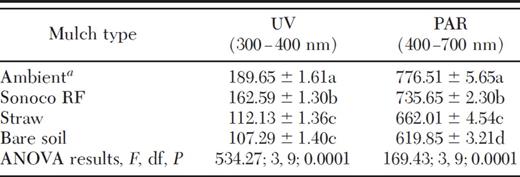
a Ambient incoming radiation.
Means followed by the same letter are not significantly different at P < 0.05. Fisher’s protected LSD.
Quanta (μmol m-2 s-1 mn-1) of UV and PAR reflected from mulches and bare soil at 15 cm from the surface

a Ambient incoming radiation.
Means followed by the same letter are not significantly different at P < 0.05. Fisher’s protected LSD.
Discussion
Previous studies have indicated that UV reflective plastic significantly delayed colonization by B. argentifolii and reduced the incidence of aphid-borne virus disease symptoms for up to 4 wk compared with unmulched controls (Brown et al. 1993; Summers and Stapleton 1998, 1999, 2002; Stapleton and Summers 2002). These mulches reflect short-wave UV light (Loebenstein and Raccah 1980, Harpaz 1982, Gibson and Rice 1989), which confuses and repels incoming alate aphids, thus reducing their incidence of alighting on plants (Kring 1962, 1972). Although similar studies demonstrating the impact of short-wave light are lacking regarding its repellency of whiteflies, evidence from numerous field studies suggests that whitefly adults respond similarly to alate aphids when approaching reflective (aluminum) surfaces (Summers and Stapleton 1998, 1999, 2002; Csizinszky et al. 1999). The current study adds support to this theory, with adult whitefly populations on plants growing over metalized mulch significantly (P < 0.05) lower than on those growing over bare soil for up to 5 wk in 2000 and 4 wk in 2001. Reduced adult populations resulted in lower nymphal populations in both years.
Wheat and rice straw also has been shown to be effective in repelling aphids and in reducing the incidence of aphid-borne viruses (Burton and Krenzer 1985, Liewehr and Cranshaw 1991). Jones (1994) and Bwye et al. (1999) found that narrow-leafed lupins, Lupinus angustifolius L., grown over cereal straw had a lower incidence of cucumber mosaic cucumovirus and bean yellow mosaic potyvirus than did plants growing over bare soil. Both attributed the reduction in virus occurrence to a decrease in the incidence of alate aphid landings. In our study, wheat straw mulch provided protection from alighting alates and aphid-borne viruses equal to that of the UV reflective plastic, and both provided significantly (P < 0.05) better protection from virus infection than did imidacloprid. This provides further evidence that insecticides, including those from newer chemistries, are generally ineffective in reducing the incidence of nonpersistently transmitted viruses by attempting to control the vector. The virus is simply acquired and transmitted too rapidly. Also, it is not uncommon to find alate aphids on the cotyledons, probably before the roots have had a chance to grow into the insecticide zone. The wheat straw also afforded protection from adult whiteflies equal to that of the UV reflective plastic in 2000 and in 2001. In 2001, fewer adult whiteflies were found on squash leaves growing over wheat straw than on the UV reflective plastic. This resulted in lower nymphal populations on plants growing over the wheat straw than on those growing over the plastic mulch.
Yields of marketable fruit mirrored the degree of silverleaf whitefly and virus disease suppression. Highest yields were from plants growing over scattered straw mulch or UV reflective plastic. These same treatments delayed the occurrence of silverleaf and virus infected plants for the longest period. Significantly (P < 0.05) higher yields from plants growing over the straw mulch in 2001 compared with the UV reflective plastic reflect the higher degree of whitefly suppression from that treatment. Whitefly populations on plants growing over the plastic mulch were similar to those on plants in the imidacloprid plots, and this similarity also is reflected in the yields.
The relationship between virus infection, silverleaf expression, whitefly infestation, and yield suppression is complicated, particularly in light of the fact that a single plant may be affected with all of these maladies. The younger the plant when infected with one or more of the viruses or colonized by B. argentifolii, the more severe the injury and the greater the yield suppression (Summers and Stapleton 1999). Infection with one or more viruses is of greater significance relative to yield suppression than is the presence of silverleaf. Virus infection causes a substantial reduction in photosynthesis and an elevation in respiration (Bawden 1964). Silvered leaves contain smaller chloroplasts (Schmalstig and McAuslane 2001) and a reduced chlorophyll level (Yokomi et al. 1995). The severity of squash silverleaf seems to be less on plants previously infected with one or more of the viruses. It is not known if some virus-induced physiological change in the leaf leads to a reduction in the severity of silverleaf expression or if virus infected leaves are less attractive to adult whiteflies, thereby leading to fewer nymphs on the leaf surface. Coata et al. (1993) found a significant correlation between the number of whitefly nymphs and the severity of silverleaf.
Although a reduction in insect and disease pressures in plants growing over plastic and straw contributed significantly to increased yields, these mulches also may have stimulated plant growth and development. Plant biomass, as determined by dry weight, was significantly (P < 0.05) higher in plants growing over plastic and straw mulches compared with those growing over bare soil (Figs. 2 and 4). Rhainds et al. (2001) reported that reflective plastic mulch enhanced productivity of strawberry plants. Van Der Werf (1993) found that the use of plastic mulch boosted dry matter yields of silage maize by 4 tons/ha and attributed the increase to advanced canopy establishment of plants growing over the mulch. Sandhu et al. (1980) obtained significantly higher yields of sugarcane in plots covered with straw mulch than in plots planted over bare soil. The latter two studies were conducted in the absence of insect and disease pressure. In the current study, increased plant growth and fruit production were definitely linked to reduced levels of insect and disease pressure, but it is also likely that PAR reflected back into the canopy helped contribute to increased growth and development. The plastic and straw mulch reflected 94 and 85% of the PAR, compared with ambient incoming radiation, back into the canopy. Mahmoudpour and Stapleton (1997) found that eggplant grown over reflective silver-painted beds produced significantly greater numbers of fruit and total fruit weight than did plants growing over various colored mulches or bare soil. The plants in this particular experiment were insect and disease free, and the authors attributed the increase in yield to a higher photosynthetic rate through increased irradiance in the plant canopy. Rhainds et al. (2001) found that in addition to repelling Lygus lineolaris (Palisot de Beauvois), reflective mulch enhanced the productivity of strawberry plants and suggested increased radiation might play a role. Porter and Etzel (1982) found that bell peppers grown on a silver reflective mulch produced greater yields than plants grown on black plastic or bare soil. This increase was found even when aphid-borne viruses were not an apparent problem. They concluded that the increased yields were probably due to increased light (PAR) reflection of the aluminum-painted mulch. Our data confirm these notions and we believe that this is the first demonstration of the reflectance of PAR back into the plant canopy from aluminum (metalized) mulch and an associated biomass and yield increase. Although spectral data were taken only in the 2001 experiment, the results were similar to those previously reported (Stapleton and Summers 1995).
Our spectral reflectance data disagree with the notion that straw acts as reflective mulch in repelling aphids (Burton and Krenzer 1985) and possibly whiteflies. Within the measured UV range, 300-400 nm, differences in reflection between the wheat straw and the bare soil were present only in the 300-320-nm range. Without more detailed information of the specific action spectra, this would be a very small window to affect either aphid or whitefly behavior. Previous studies have noted higher capture rates of alate aphids over dark backgrounds than over light backgrounds (Liewehr and Cranshaw 1991).
The precise economics of the various treatments are difficult to assess. Jetter et al. (2001) described the gross annual benefit (GAB) of using a new technology instead of the next best alternative. GAB is estimated as the proportional change in yield, plus the proportional increase in quality plus the proportional increase in price per cwt gained by marketing at the correct time, minus the proportional decrease in variable costs for the application of the new technology, all multiplied by the actual gross value of production using the new technology in the presence of the pest(s) and then multiplied by the fraction of acreage on which the new technology was adopted. The combination of injury due to whitefly feeding and virus infection further complicates the situation. In many cases, including the current study, failure to manage whiteflies and viruses resulted in a virtual absence of marketable fruit. The cost of imidacloprid depends on the number of applications required to maintain low levels of whitefly infestations plus the possible need for additional insecticides. As noted, imidacloprid was not particularly effective in reducing the incidence and severity of virus infections. The cost of plastic mulch depends on mulch thickness, quantity ordered, width of roll and shipping distance. The price of wheat straw depends on time of season, supply and demand, and transportation costs. Wheat straw has the advantage that it can become part of the overall production system in a conservation tillage program. Wheat can be planted, harvested, and the grain marketed and then squash planted as a no-till crop following wheat. This approach, however, is not without its own set of problems. Planting and harvesting wheat requires special equipment that is not likely to be owned by most vegetable growers. Conservation tillage also requires its own set of equipment to establish a crop following wheat. A very generalized price estimate is that the cost of plastic reflective mulch > the cost of wheat straw (hand scattered) > imidacloprid. The effectiveness of these strategies is plastic reflective mulch = straw mulch > imidacloprid > conventional strategies. Individual growers will need to determine the most cost-effective combinations of management strategies for their own situation.
We appreciate the technical assistance of Albert Newton, Susan Mallek, and Ryan Smith. We are grateful to Nick Dokoozlian for assistance with the spectral reflectance readings. Beth Grafton-Cardwell greatly improved the manuscript with thoughtful review. We thank Lois Strole for editorial assistance. Portions of this research were supported by the University of California Integrated Pest Management Project and the California Department of Pesticide Regulation. We thank Sonoco for the donation of the plastic reflective mulch and Bayer for the contribution of imidacloprid insecticide.
References Cited



